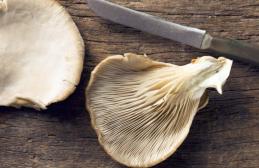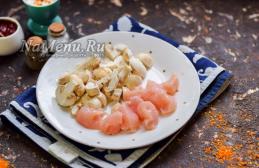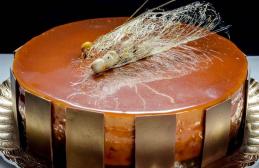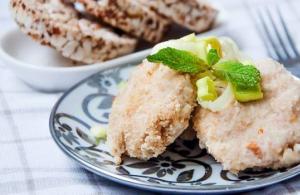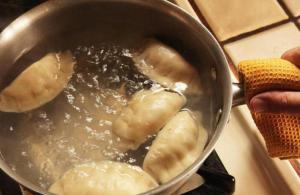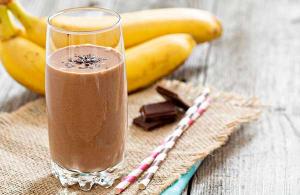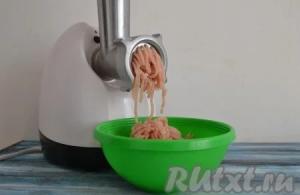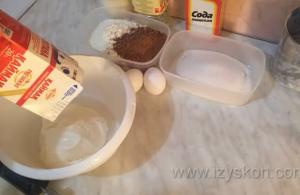Kira Stoletova
Oyster mushrooms are one of the most popular types of mushrooms among consumers. They are unpretentious to grow and care for and are suitable for preparing many dishes. They are bred at home or collected in the forest. Cleaning oyster mushrooms is a process that takes little time.

Features of cleaning oyster mushrooms
If the oyster mushroom was purchased in a store, it was grown under artificial conditions, so it is not necessary to cut off the skin. Fruit bodies collected in the forest should be cleaned.
There are basic rules for cleaning oyster mushrooms:
- Mushrooms should not be left to sit for a long time after being picked or purchased. The longer this happens, the higher the risk of poisoning.
- Oyster mushrooms should not be immediately placed in water. First, remove all dirt with a brush or dry sponge.
- To prevent darkening, leave the product in salted water for 15-20 minutes. The procedure is also necessary for store-bought mushrooms: they can also contain pests.
Irina Selyutina (Biologist):
Yes, even oyster mushrooms bought in a supermarket require cleaning, because there may be dark spots on the surface of the fruiting bodies that require removal. Although this group of mushrooms is rarely affected by worms, cleaning is required. Of course, spoiled specimens will not cause harm to health, but the appearance of the dishes, and perhaps also the mood, will be spoiled.
Do not forget: Oyster mushrooms of good quality must have a gray-bluish color of the caps without admixtures of other shades and, accordingly, various spots.
By the way. After removing the damaged parts, the oyster mushrooms are washed again, but only under a weak stream of water.
Cleaning oyster mushrooms in the forest
The initial cleaning of oyster mushrooms should be carried out in the forest. This mushroom grows on stumps and tree trunks. Before putting it in the basket, you need to remove any remaining leaves and twigs that may be on it.
It is convenient to remove stuck debris using a knife. Places with wormholes are also immediately cut off. Oyster mushrooms are cleaned more thoroughly at home.
Cleaning oyster mushrooms at home
Mushrooms of this group spoil quickly. Before peeling oyster mushrooms, perform the following steps:
- they are sorted, mushrooms are distributed separately for cooking options: canning and frying;
- rinse thoroughly and leave in water for 30 minutes;
- after the mushrooms lie soaked, worms begin to emerge from them;
- Dust and dirt often accumulate under the caps, so they are washed with a soft brush;
- if the stains are not washed off, they are carefully cut out with a knife;
- dry on a soft towel or paper napkins;
- mushrooms intended for drying are not washed.

To clean mushrooms, take a thin sharp knife, a clean and dry sponge (a soft rag will do), and a colander. Next, cut off the end of the stem of each mushroom. The longer you plan to store the product in the refrigerator, the larger part is removed. This is necessary so that the mushrooms do not lose their taste and begin to deteriorate.
Irina Selyutina (Biologist):
If you use a small amount of oyster mushrooms for the preparation, then it is best to rinse them in portions under running water using a colander. All manipulations must be carried out very carefully, because... These mushrooms are particularly fragile and the slightest awkward movement can damage the mushroom cap.
Many housewives prefer cleaning the fruiting bodies of oyster mushrooms using running water, which takes a little time.
Additional cleaning
There are several simple ways to do additional cleaning:
- Blanching: fresh mushrooms are placed in a container and poured with boiling water, then left in the same hot water for a few seconds. This treatment helps make them more elastic. Usually this manipulation is carried out before marinating.
- Boiling: Place the mushrooms in a saucepan and bring to a boil over high heat. When the water boils, turn it off and let it cool.
- Boiling: Place the mushrooms in a container with cold salted water and bring it to a boil. Let cool for 15 minutes and rinse with cold water in a colander.
For your information. Before drying, oyster mushrooms, like other mushrooms, are not washed or boiled. All preparatory manipulations are carried out only on dry mushrooms.
Mushrooms are a very healthy and tasty product. A wide variety of food is prepared from them - sauces, soups, salads, main courses. Oyster mushrooms are considered the most popular to eat. They are collected in the forest from tree trunks, and are also grown at home on sawdust or sunflower seed husks. Before cooking, mushrooms should be washed thoroughly. But do they need to be processed and how to clean fresh oyster mushrooms before cooking and frying? - This is a question that many housewives ask. Of course, in order for the finished dish to be tasty, the products must be pre-processed and inedible parts must be removed. Let's look at everything in more detail in this article.
Important! This type of mushroom has become popular due to the fact that it is impossible to get poisoned by them, since they do not contain harmful toxic substances. Therefore, even if the cooked product is damp, it will not affect your health.
How to properly clean oyster mushrooms?
If the mushrooms have not accumulated a huge amount of dirt and debris, they will still have to be washed. A huge number of microbes accumulate under the mushroom cap, which adversely affect the human body.
If you have collected them or bought a large quantity, then you need to clean the oyster mushrooms as follows:
- Pour cold water over the mushrooms.
- We leave them in this state for half an hour.
- Mix with your hands and remove large debris.
- We wash the mushrooms under running water.
Important! If you decide to cook a small amount of mushrooms, then you need to wash them in portions. Place the oyster mushrooms in a colander and rinse them with cold running water. This method will rid your products of debris and dust.
The process of processing mushrooms involves not only washing with water, but also cutting off inedible, spoiled parts. The dried areas are cut off with a knife, and the cut area is wiped with a dry cloth.
Important! Dry cleaning is a must. Especially if you plan to freeze oyster mushrooms.
Step-by-step instructions for cleaning oyster mushrooms
Since this type of mushroom grows only on tree trunks and old stumps, the risk of contamination is low. But still, you should play it safe and properly clean the oyster mushrooms. 
Important! They can be pickled, salted, fried, or added to meat or vegetable dishes.
Let's look at a few simple steps for cleaning oyster mushrooms:
- For processing you will need a sieve or colander, a foam sponge and a knife.
- We wipe the stem and cap of the mushroom with a foam sponge, carefully removing small debris and dust.
- Trim off the contaminated bottom of the stem and cut off any damaged or dry areas.
- Rinse the mushrooms under running cold water, after placing them in a strainer or colander.
- Pat the mushrooms dry on a paper towel.
Important! All manipulations must be done very carefully, since oyster mushrooms are a rather fragile product. The slightest sudden movement can damage the mushroom cap.
By following this simple algorithm of actions, you will be able to properly prepare mushrooms for cooking.
- Boiling - place mushrooms in a saucepan of cold water and bring to a boil, adding a little salt to the water. After boiling, keep in this state for 15-30 minutes. Then place the vegetable products in a colander and rinse with cold water.
- Boiling - place the mushrooms in a container of water and bring them to a boil as quickly as possible. As soon as the water boils, immediately turn off the heat and leave to cool without removing the mushrooms. After cooling, the products are placed in a fabric bag to dry.
- Blanching - the mushrooms are placed in a sieve and poured over with boiling water. Afterwards, place them in boiling water for a few seconds or keep them over steam. After such heat treatment, the mushrooms become more durable and do not break. Carrying out this manipulation is typical for pickling mushrooms.
Important! When boiling or boiling, you should never squeeze the mushrooms, as a lot of valuable substances are subsequently lost.
Advantages and disadvantages of oyster mushrooms
This type of mushroom contains a lot of useful substances for the human body. That is why they are very often eaten.
Let's look at the main advantages of this product:
- They have very low calorie content. But if consumed in large quantities, they can satisfy hunger.
- They contain minerals such as potassium, iron, calcium and iodine.
- Promotes the breakdown of fats.
- Enriched with vitamins: C, D2, B, E and PP. Thanks to them, the product is very similar to meat.
- Remove radioactive substances from the body.
- Reduces cholesterol levels.
Important! As a result of using this product in food, the development of E. coli in the human body is prevented. The human body's resistance to radiation also increases.
When preparing such a product, it is definitely recommended to process it, since it contains chitin, which humans cannot digest. In order to remove chitin, the mushrooms need to be cut very finely and fried well.
Important! One of the most important disadvantages is the not very pronounced mushroom smell. In addition, this type of vegetable products is not resistant to infection by viral diseases. In addition, they are quite difficult to transport, since the fruiting body is very fragile and unstable.
Mushrooms are a natural, forest product that does not leave any gourmet indifferent. The product is widely used in various areas of cooking and makes the taste of cooked dishes brighter. The fruits of the crop are added to salads, sauces, baked goods, soups and other hot dishes, and also pickled or pickled as winter reserves.
After harvesting, the forest harvest must be carefully processed, only then can the fruits be eaten. Today we will discuss how to clean oyster mushrooms, because this particular type of mushroom is very popular among lovers of “quiet hunting”.
How to clean fresh oyster mushrooms before cooking
If you bought mushrooms at the market, most likely the seller took care of the presentation of the fruits and cleaned them in advance. Is the purchased product unprocessed or just brought from the forest by you? Pay attention to the manipulations that the crop must be subjected to before using it in the preparation of any dishes:
- Examine fresh fruit for soil, debris and damage. Cut away any worm-eaten, dried-out or mixed-in wood areas. It is very important not to skip this stage, as without it the prepared dish may be spoiled. It is better to clean carefully, without cutting off excess, so as not to waste the precious product.
- If there are few mushrooms, rinse each fruiting body under running water, paying special attention to the back of the cap (the place where the plates are located).
- The harvest is large, but washing takes a long time? Place the oyster mushrooms in a large tank or bathtub and fill with clean, cold water. Leave to soak for about 30 minutes.
- After the specified time has passed, mix the product with your hands, manually collect any debris that floats to the surface (leaves, twigs, bugs).
- Select a batch of mushrooms from the container, rinsing each one under the tap.
- Place clean fruits in a prepared container.
How to properly clean oyster mushrooms (video)
Result: thoroughly washed, cut up, let's start cooking!
Further processing depends on the purpose for which the mushrooms were collected or purchased. If you plan to “use” the product as a salad ingredient, cut it into small pieces and place it in a hot frying pan.
Mushrooms are living organisms that belong neither to plants nor to the animal world. They are studied by mycology, a separate branch of botany. This is due to the fact that previously these organisms belonged to the plant kingdom. Their very existence is covered with a certain touch of the mysterious and unusual. They have been used since ancient times in all kinds of magical rituals. Mentions of them can be found both in folk tales and in the mystical works of Castaneda. But most people are interested, nevertheless, exclusively in the gastronomic qualities of mushrooms. And also whether it is worth cleaning them before cooking, and how to do it correctly.
Do I need to peel mushrooms?
If you purchased oyster mushrooms or champignons at the store, you don’t have to peel them. They were most likely grown artificially, so there is no need for mandatory cleaning. Although it should be understood that the place in which they were grown was unlikely to be completely sterile, so it will be necessary to wash them before cooking. Mushrooms collected in the natural environment, in a forest or planting, must be cleaned, regardless of the environmental situation in the area where they were collected. 
Main features of the process
A few simple processing rules that are relevant for any mushrooms, both forest and artificially grown:
- It is necessary to process the fruiting body as soon as possible after collection. The more time passes from the moment of collection to preparation, the higher the likelihood of poisoning;
- First, you should sort by quality indicators and size;
- There is no need to wash the mushrooms right away. First, use a knife and brush to remove sand, soil and other debris;
- then you need to soak the crop in salt water. This procedure will prevent blackening of the fruit, and will also force worms that were undetected during inspection to leave their refuge.
Did you know? The tradition of going mushroom picking has been preserved only here and in Eastern and Central Europe. In the west of the European continent, only mushrooms grown in greenhouses, mainly champignons, are eaten.
Is it worth washing mushrooms?
If mushrooms are collected or purchased for further drying, they should not be washed. A thorough dry cleaning will be sufficient. In all other cases, procedures with salt baths are recommended. The fact is that most mushrooms absorb moisture very well, but then release it poorly. If you are going to dry or freeze the harvest, you should not wash it; if you are going to heat-treat it, then wash it.  It is recommended to soak any mushrooms in a salt solution. This procedure is aimed not so much at removing soil, sand and leaves (all this can be removed dry), but at getting rid of worms. Any fruiting body, even the healthiest one grown in the natural environment, is a home for worms. If you are patient, you can get rid of them.
It is recommended to soak any mushrooms in a salt solution. This procedure is aimed not so much at removing soil, sand and leaves (all this can be removed dry), but at getting rid of worms. Any fruiting body, even the healthiest one grown in the natural environment, is a home for worms. If you are patient, you can get rid of them.
Cleaning mushrooms
The general cleaning rules for all varieties of mushrooms are largely similar. However, there are some differences, depending primarily on whether the crop was harvested in its natural habitat, or whether the mushroom was grown artificially.
Important! The high content of chitin does not allow feeding mushrooms to children under 14 years of age, since this polysaccharide is not broken down by the child’s body until this age.
White
To begin, thoroughly dry clean the boletus (Boletaceae family) as indicated above. Carefully inspect the entire fruiting body, paying special attention to the area under the cap. Use a brush to remove debris, grass, sand and leaves. If you are going to dry the boletus, wipe it with a damp cloth. In this case, no further manipulations with water should be carried out.
The remaining mushrooms intended for cooking (heat treatment) should be washed in cold water. If the cap and stem are clean, there is no need to soak them in a salt solution. If they were collected after rain, or there are obvious traces of dirt on the surface, then you will still need to soak them in a salt solution (1 tablespoon of salt per 1 liter of water). Soak in salt water for 20 minutes. After this time, the boletus mushrooms should be removed and the water with the worms should be drained. Repeat the procedure until the water after the mushrooms remains clean and free of worms.
Oyster mushrooms
Although oyster mushrooms must be grown in sterile conditions, they still need to be washed before cooking. The fact is that bacteria accumulate under the cap and must be removed.
Fill them with water for 30 minutes. Periodically stir the contents with your hand to create a slight movement of water. You should not wash oyster mushrooms under a strong stream of water, as the fruiting body is very fragile, and the pressure of tap water can damage them.Did you know? A dream in which you peel mushrooms is often interpreted as a subconscious desire to bring order to your own life, to get away from old habits and everyday life. Another meaning of sleep (according to Freud): if there is only one mushroom, you should pay attention to your men's health(for men).
After each stirring, water with any debris that has got into it should be drained and new water should be added. Then place the oyster mushrooms in a colander, rinse under low pressure and carefully inspect for spoilage, dry calluses, and other places that need to be removed. Dry, blackened, spoiled areas must be cut off, and all clean mushrooms must be carefully wiped with a dry cloth and placed on a paper towel. 
Champignon
If the champignons are small in size, but they are fresh, quite dense and strong, it is enough to brush them and cut off the stem by 2-3 mm, then rinse them in running water and lay them out to dry on a dry towel. Larger champignons are cleaned in a similar way, carefully inspecting possible spoilage and damage, which should be removed with a knife.
If the champignons are not the freshest, it is necessary to remove the skin from the surface. This procedure is done using a knife. You need to pry off the top layer from the edge of the cap, and, grabbing it with a knife, remove it, moving through the top of the head to the opposite edge of the cap. The worse the skin peels off the champignon, the fresher it is. The taste of champignons is negatively affected by water. In this regard, the mushrooms should be washed quickly and immediately laid out to dry on a towel.Butter
To begin with, you need to carry out the procedures that should be used for all mushrooms - inspection, sorting and dry cleaning. Further processing depends on how you plan to prepare the butter. If the mushrooms are subsequently subjected to heat treatment, you should remove the film and mucous layer from the cap, rinse the fruiting bodies under running water and leave the boletus to dry on a towel. If they are intended for freezing or drying, there is no need to wash them, just wipe them with a damp cloth.
Important! There is no need to soak the boletus in water, as this increases the stickiness and stickiness of the mucus on the caps. Treat the fruiting body with boiling water or steam for 30 seconds; this procedure will significantly facilitate future processing.
Zelenki
If you collect greenfinches (rowed plants) in the forest yourself, it would be advisable to carry out preliminary cleaning on site. In nature, greenfinches are almost completely covered with sand, the bulk of which, as well as grass and other weeds, is best left in the forest. To do this, carefully remove the soil, sand and grass, and cut off the bottom of the stem. Then take the greenfinch vertically by the stem and lightly tap the cap on top. This manipulation will help remove the bulk of the sand, the remains of which can be washed off at home.  Greenfinches have two remarkable qualities:
Greenfinches have two remarkable qualities:
- they are collected in mid-autumn, when there are no other mushrooms;
- Greenfinch does not absorb water well.
- pour water into a basin or large saucepan, add a few tablespoons of salt;
- pour greenberries into the container;
- stir the rows periodically, after an hour, carefully remove them with a slotted spoon, trying not to lift the settled sand from the bottom;
- rinse the crop in running water.
You can also remove excess sand by boiling:
- rinse the greenfinches with tap water;
- fill the row with water, the volume of which should be 3 times more than the volume of mushrooms;
- put on fire, bring to a boil and boil a little, there is no need to stir, the sand will settle to the bottom;
- then remove the mushrooms and rinse under running water.
Honey mushrooms
Honey mushrooms quickly darken and lose their condition. For this reason, they need to be processed as quickly as possible. After dry cleaning, sort the mushrooms. Those that go for drying or freezing are not washed. It will be enough to treat them with a damp cloth. If you are going to pickle, boil or fry them, soak the mushrooms in a salt solution for 30-40 minutes, then remove the skirts, film and mucus from the caps. Then place the mushrooms on a dry towel to remove excess water.
Valui
Valuy belongs to the russula family. In Europe, it is considered inedible due to its characteristic bitterness and unpleasant odor. However, we use them for food; marinated and salted valui are especially good. For food use, young valui with a diameter of up to 5 cm are taken.  You should first dry-clean the valui (especially carefully remove the skin from the cap), and then soak it in water with salt for two to three days. After soaking the relatives, the russula should be boiled for 15 minutes. Now they are ready for further salting or pickling.
You should first dry-clean the valui (especially carefully remove the skin from the cap), and then soak it in water with salt for two to three days. After soaking the relatives, the russula should be boiled for 15 minutes. Now they are ready for further salting or pickling.
Saffron milk caps
Mushroom pickers consider saffron milk caps to be one of the cleanest mushrooms. This statement has a basis. The only problem area of the saffron milk cap is the slightly sticky cap. If the saffron milk caps are going to be dried or frozen, you should limit yourself to dry cleaning only - lightly wipe the cap with a damp cloth, then spread it out to dry in a thin layer.
If you plan to make soup, fry or pickle saffron milk caps, then after dry cleaning it would be a good idea to soak them for 30-40 minutes in a salt solution. And then rinse in running water.
Polish
The Polish mushroom in various classifications belongs to the boletus family, that is, it is a sibling of the boletus mushroom. Accordingly, the procedure for washing and cleaning it is completely similar to that carried out for boletus. 
Did you know? The honey mushroom (Armillaria ostoyae) is the largest living organism on Earth. Its mycelium covers an area of 9.65 square meters. km, in the Blue Mountains of Oregon, located in the USA. The age of this mushroom is approximately 2500 years.
Chanterelles
Chanterelles are valued by both gourmets and chefs for their taste and nutritional qualities. In addition, it is believed that they grow exclusively in ecologically clean areas. Preliminary cleaning should be carried out in the forest, at the collection site. If you purchased chanterelles and did not collect them yourself, first you need to clean them using the dry method described above. Then immerse the mushrooms in a container of cold, salted water. They should be placed in the water one at a time, carefully examining each fruiting body. Using a brush and knife, remove problem areas, dirt, and dark spots. Leave the chanterelles in the water for 40 minutes, then carefully remove them and leave to dry. Benefits of eating:
- rich in protein (there is as much protein in boletus as in meat, while there is almost no fat);
- quickly satisfy the feeling of hunger, while they can be eaten as a dietary product due to their low calorie content and low fat percentage;
- the vitamin complex has a positive effect on the body and appearance;
- normalize blood flow;
- have a beneficial effect on work;
- normalize metabolic processes in the body;
- have a positive effect on.
Important! Champignons should be cleaned immediately before cooking; they should not be stored peeled or cut. Taste qualities are lost very quickly during such storage.
Harm of mushrooms:- toxicity. The fact is that in modern ecology, even edible mushrooms can be poisonous, since the porous surface of the fruiting body is an excellent absorbent, absorbing toxic substances;
- There are also quite a few mushrooms that look very similar to edible ones, but are actually poisonous. Beginner mushroom pickers can easily make a mistake, which can lead to death;
- Vegetarians are trying to get a complete replacement for animal protein from mushrooms. But this is impossible to do because of chitin. Its high consumption leads to serious gastrointestinal problems.
Fresh mushrooms, especially if they are collected in rainy weather, quickly deteriorate. Therefore, you should clean them immediately upon returning home. If this cannot be done, the mushrooms should be placed in the refrigerator without rinsing with water and processed the next day. The exception is milk mushrooms, which are washed and then soaked in water for three days. The water needs to be changed at least five to six times a day. This operation will remove the bitter taste from the mushrooms.
Experienced lovers of quiet hunting, even when picking mushrooms in the forest, perform a small initial cleaning - remove grass, pieces of earth and foliage stuck to the mushroom and cut off the root. By looking at the cut on the stem, you can determine whether there are worms inside.
Only properly prepared mushrooms will delight you with their presence in your favorite dishes. Different types of forest beauties require the use of different processing techniques, because mushrooms can grow in different conditions. The difference in mushroom cap structure also affects how to work with mushrooms. According to the structure of the cap, mushrooms are:
- marsupials (morels, raincoat, common stitch);
- lamellar (milk mushrooms, honey mushrooms, saffron milk caps, greenfinches, russula, champignons, etc.);
- tubular (white and Polish mushrooms, boletus mushrooms, boletus mushrooms, oak mushrooms, boletus mushrooms).
So, let's look at how to properly peel mushrooms, the most common ones in our latitudes.
Oyster mushrooms purchased at the market or supermarket, as a rule, do not need pre-treatment; before cooking, it is enough to rinse them well with water. Whether it is necessary to peel oyster mushrooms grown in natural conditions depends on the condition of the mushrooms. They grow on trees, so there is practically no small debris stuck to them.
Champignon. For very large champignons, it is advisable to remove the skin from the cap. The most convenient way to do this is with a knife, moving from the edge of the cap to the center. It is advisable to remove the hard legs of the champignons or cut them shorter. Since they strongly absorb water, it is better to use dry treatment if possible, cleaning them with a dry cloth or towel.
Porcini mushrooms: before cleaning porcini mushrooms, fan their caps with a brush or dry cloth, removing blades of grass and other small debris. After this, cut off the lower part of the root, on which the earth usually sticks and all the places damaged and spoiled by worms. Boletus mushrooms slightly spoiled by worms are quite suitable for drying; during the drying process, the worms will come out.
Boletuses and boletuses: these two species are processed in approximately the same way. The skin cannot be removed from the cap, but it is advisable to remove it from the stem. Boletuses and boletuses are often affected by worms. There may be worms in the lower part of the cap, but there may not be any in the rest of the cap. It is best to remove the spongy layer under the cap.
Boletus mushrooms: compared to previous types, the task of peeling boletus mushrooms seems more difficult. The slippery film covering the heads of the oil becomes coarse during heat treatment and afterward becomes slightly bitter, so it is imperative to remove it. To make it less slippery, the mushrooms need to be doused with boiling water or, if there is time, dried a little. After this, it is easy to remove the film with a knife, prying it up at the edge of the cap and tearing it off towards the center.
Honey mushrooms: if you want to enjoy pickled mushrooms, then you definitely need to know how to properly clean honey mushrooms. Honey mushrooms, due to their structure, as a rule, are practically not contaminated. If necessary, you need to cut off the damaged areas of the cap and the lower part of the stem, and collect the leaves and blades of grass that have stuck to them.
If you follow these recommendations, you can quickly and efficiently prepare the collected mushrooms and use them to prepare your favorite dishes or freeze, dry, or preserve them. There are a large number of edible species of mushrooms in nature; you should not use specimens if there is even the slightest doubt about the safety of eating them.
Do I need to boil oyster mushrooms before frying?
Before finding out how long to cook oyster mushrooms for frying, and whether boiling is necessary in principle, let’s start cleaning them. If mushrooms are collected in the forest, or in your own mushroom farm, they remain contaminated. Mushrooms bought in stores usually do not have them, but they also require careful inspection.
- We wipe the caps and legs of oyster mushrooms with a dish sponge, removing dust and remaining natural debris.
- We cut off the ends of the stems and cut out damaged, dark and dry places from the mushrooms.
- If the mushrooms were purchased at the market or in a store, we thinly trim the cut points: they have time to dry out and become rough.
- Carefully, so as not to break the fragile fruiting bodies, rinse the oyster mushrooms under a weak stream of water, placing them in a colander: this will drain away the moisture that interferes with normal frying faster.
Be sure to dry the mushrooms with paper towels before boiling and frying: excess moisture makes the food too watery.
Many housewives are interested in whether it is worth boiling oyster mushrooms before frying them in a frying pan. Even professional chefs with extensive experience differ in their opinions on this issue.
- Some believe that it is better to boil the mushrooms before frying, but no more than five minutes.
- Others are confident that oyster mushrooms do not need to be pre-boiled, since they are completely safe for human health, they contain enough moisture for a full cooking cycle, and they will not dry out in a frying pan.
Let's find out how long to cook tender mushrooms if you decide to boil them before frying, and what are the methods of preliminary heat treatment.
Boiling oyster mushrooms
- Boil water, add some salt and add whole oyster mushrooms or sliced oyster mushrooms (cut them large or medium).
- Cook over moderate heat for five minutes and turn off the stove.
- Place the mushrooms in a colander, removing unnecessary moisture from the product.
After boiling, a fragrant broth remains, on the basis of which an excellent mushroom soup or puree soup is obtained.
Boiling
- Pour cold water into the pan and add the oyster mushrooms.
- We wait for it to boil and add some salt to the broth.
- How long should oyster mushrooms be boiled before further frying in this case? Boil mushrooms for 15 minutes. and drain in a colander.
Finally, rinse the mushrooms with cold water, remove excess moisture again and proceed to frying.
Blanching
- Place the oyster mushrooms in a sieve and pour over boiling water.
- We hold them over the steam for 10 seconds.
- Dry the mushrooms and start frying.
After blanching, they cease to be brittle and brittle and retain their integrity when fried. By the way, such processing is usually carried out before salting oyster mushrooms. This method is the best solution to answer the question of whether it is necessary to boil oyster mushrooms before frying, because heat treatment is minimal.
Now it’s clear how to clean dirt from mushrooms and rinse them, avoiding damage to the fragile fruiting bodies. Having found out whether oyster mushrooms need to be washed before frying, all that remains is to decide whether to boil them. When you don’t have time to cook, you can blanch the mushrooms or fry them right away: both boiled and fresh oyster mushrooms are completely safe for life and health.
Initial processing
Upon returning home, you need to sort out the mushrooms, sort them, cut off damaged areas, and, if necessary, rinse them with water. Mushrooms that you plan to dry for the winter are not washed; you can only wipe them with a damp cloth. After this, you can proceed directly to cleaning. For this you will need:
- comfortable, well-sharpened knife;
- clean rags or towels, you can use paper ones;
- thin rubber gloves that will protect your hands from mushroom juice. Working without gloves can lead to blackened fingertips.

